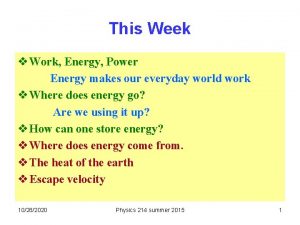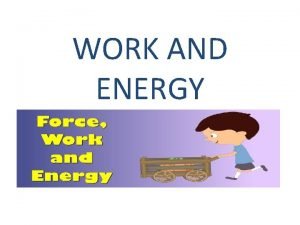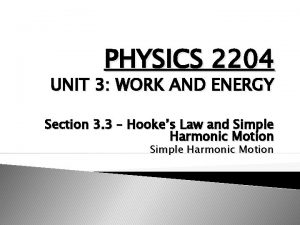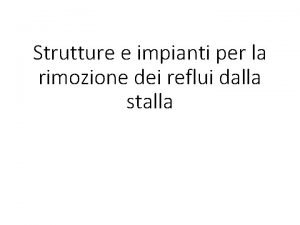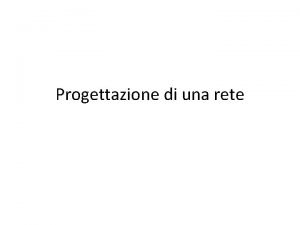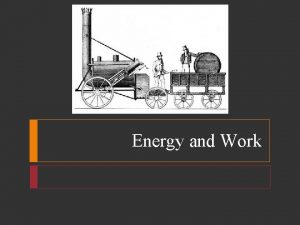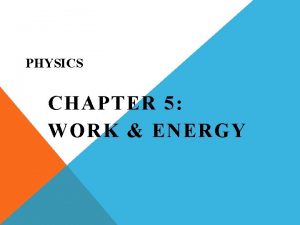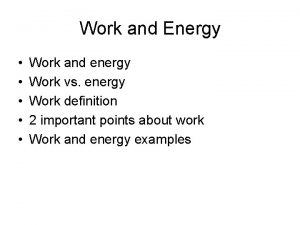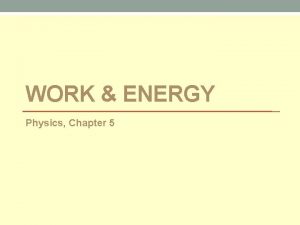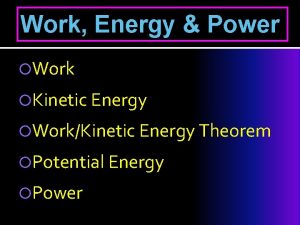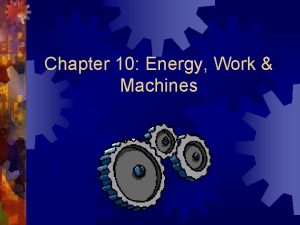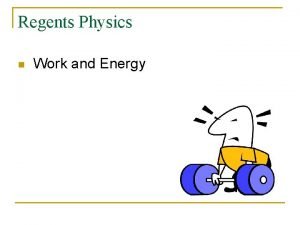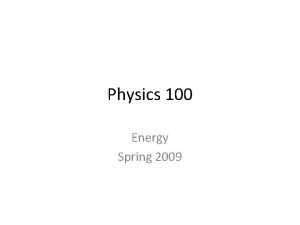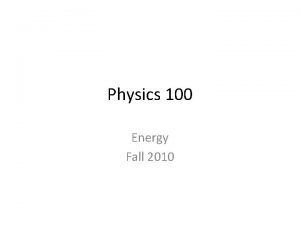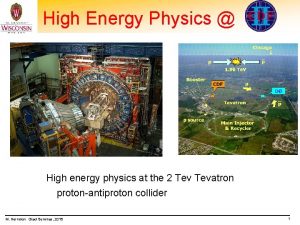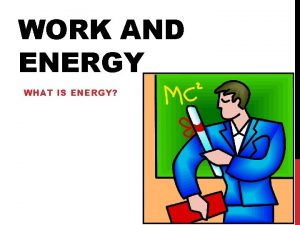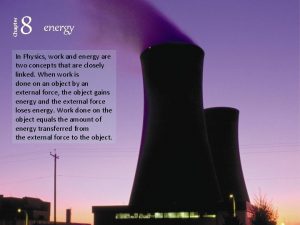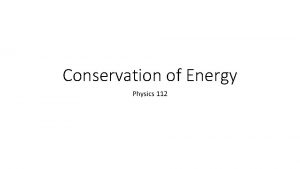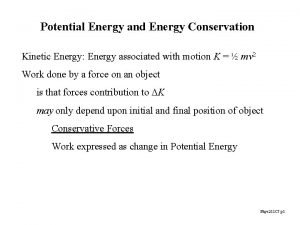Progetto Physics in English Work and energy WORK

























- Slides: 25

Progetto “Physics in English” Work and energy WORK IS DONE ON AN OBJECT WH EN A F ORCE CAUSES A DIS PLACE MENT OF THE OBJE CT Prof. ssa A. Martorana

WORK Positive work is done on a textbook when it is raised vertically at a constant velocity. A force resulted in a displacement. Work was done. Displacement means change in position, from origin to finish.

EXAMPLE Imagine that your car has run out of gas and you have to push it down the road to the petrol station.

Example If you push the car with a costant horizontal force, the work you do on the car is equal to the magnitude of the Force F times the magnitude of the displacement of the car W = Fd Work is not done on an object unless the object is moved with the action of a force

WORK Read the following statements and determine whether or not they represent examples of work.

Statement A teacher applies a force to a wall and becomes exhausted.

Answer No. This is not an example of work. The wall is not displaced. A force must cause a displacement in order for work to be done.

Statement A book falls off a table and free falls to the ground.

Answer Yes. This is an example of work. There is a force (gravity) which acts on the book which causes it to be displaced in a downward direction (i. e. , "fall").

Statement A rocket accelerates through space.

Answer Yes. This is an example of work. There is a force (the expelled gases push on the rocket) which causes the rocket to be displaced through space.

WORK However, the application of a force alone does not constitute work Work is done only when components of a force are parallel to a displacement

WORK When the force on an object and the object’s displacement are in different directions, only the component of the force that is parallel to the object’s displacement does work. Components of the force perpendicular to a displacement do not work

Example A waiter carries a tray full of meals above his head by one arm straight across the room at constant speed. Is this an example of work being done on an object?

Answer No. This is not an example of work. There is a force (the waiter pushes up on the tray) and there is a displacement (the tray is moved horizontally across the room). Yet the force does not cause the displacement. To cause a displacement, there must be a component of force in the direction of the displacement.

Explanation The waiter does not do work upon the tray as he carries it across the room. The force supplied by the waiter on the tray is an upward force and the displacement of the tray is a horizontal displacement. As such, the angle between the force and the displacement is 90 degrees. If the work done by the waiter on the tray were to be calculated, then the results would be 0.

Important! A vertical force can never cause a horizontal displacement; thus, a vertical force does not do work on a horizontally displaced object!!

WORK Mathematically, work can be expressed by the following equation. net work=net force×displacement×cosine of the angle between them

WORK Wnet= Fnetd cos Ѳ F is the net force, d is the displacement, and the angle (theta) is defined as the angle between the net force and the displacement vector. The angle is a very specific angle; the angle measure is defined as the angle between the force and the displacement.

WORK Sample problem: How much work is done on a vacuum cleaner pulled 3. 0 m by a force of 50. 0 N at an angle of 30. 0° above the horizontal?

WORK The sign of work is important Work is a scalar quantity and can be positive or negative. It is positive when the component of force is in the same direction as the displacement. Work is negative when the force is in the direction opposite the displacement.

THE MEANING OF NEGATIVE WORK On occasion, a force acts upon a moving object to hinder a displacement. (hinder - to interfere with action or progress). An example might include a car skidding to a stop on a roadway surface. In such an instance, the force acts in the direction opposite the object’s motion in order to slow it down. The force doesn't cause the displacement but rather hinders it.

WORK Work is negative when the force is in the direction opposite to the displacement. For example, the force of kinetic friction between a sliding box and the floor is opposite to the displacement of the box, so the work done by the force of friction on the box is negative. cos Ѳ is negative for angles greater than 90° but less than 270°

WORK Units of Work Whenever a new quantity is introduced in Physics, the standard metric units associated with that quantity are discussed.

WORK In the case of work (and also energy), the standard metric unit is the Joule (abbreviated J). One Joule is equivalent to one Newton of force causing a displacement of one meter. In other words, The Joule is the unit of work. 1 Joule = 1 Newton × 1 meter 1 J = 1 N × m
 Physics 03-06 impulse and momentum answer key
Physics 03-06 impulse and momentum answer key F= ma units
F= ma units Define work energy theorem
Define work energy theorem Sound energy
Sound energy Chapter 4 work and energy section 1 work and machines
Chapter 4 work and energy section 1 work and machines Energy energy transfer and general energy analysis
Energy energy transfer and general energy analysis Energy energy transfer and general energy analysis
Energy energy transfer and general energy analysis 0kei0
0kei0 Unit of resistivity
Unit of resistivity Physics 2204 unit 3: work, power, energy
Physics 2204 unit 3: work, power, energy Chemical potential energy images
Chemical potential energy images Modern physics vs classical physics
Modern physics vs classical physics University physics with modern physics fifteenth edition
University physics with modern physics fifteenth edition Linkedin
Linkedin Progetto stalla suini
Progetto stalla suini Obiettivi generali e specifici di un progetto esempio
Obiettivi generali e specifici di un progetto esempio Relazione finale referente bullismo
Relazione finale referente bullismo Attività sull'alimentazione scuola primaria
Attività sull'alimentazione scuola primaria Governance di progetto
Governance di progetto Progetto basilicata donna
Progetto basilicata donna Progetto un mondo a colori
Progetto un mondo a colori Immagini sull acqua
Immagini sull acqua Progettazione di una rete
Progettazione di una rete Progetto prin esempio
Progetto prin esempio Progetto pcto esempio
Progetto pcto esempio Progetto interdisciplinare pinocchio
Progetto interdisciplinare pinocchio

